TWO CLOCKS BY BAETENS & CO OF SOHO, LONDON
November 2nd 2015
By the Regency period London’s clock and watch making industry was vast. It is estimated that by 1800 there were over 7,000 clock and watchmakers based in Clerkenwell alone. More and more people were buying clocks, watches and barometers, and they appeared in every sort of design, style and finish.
One of the companies to take advantage of this burgeoning business was Baetens & Co. It was based from at least 1814 at 23 Gerrard Street in Soho, and was run by F. Baetens, who appears to have later gone into business with his son or relative Joseph Baetens.
Baetens & Co were not traditional clockmakers as you would have found in the first half of the 18th century – they seem not to have been “clockmakers” in the traditional sense at all, but rather specialist craftsmen in ormolu and bronze. Where in the early 18th century clockmakers had made the various parts of the clock movement and put these together, they generally had not make the cases, working instead with cabinet makers who produced cases in fine woods for them.
Baetens & Co are an example of the expansion and development of the clockmaking business in London – they made exquisite ormolu mounts and ormolu and bronze clock cases and then bought in ready-made clock movements to fit into their designs, signing and marketing the finished product.
Raffety currently has two fine examples of Baetens & Co clocks on view in the gallery.
The first is a small and unusual library timepiece in neo-classical style, consisting of a white enamelled clock set into an ormolu and gilded mount, on a white marble base. The original ormolu mounts include swag decoration to the marble base and elegant, turned feet. The top of the clock is crowned with gilded ormolu ribbons. It probably dates to about 1830.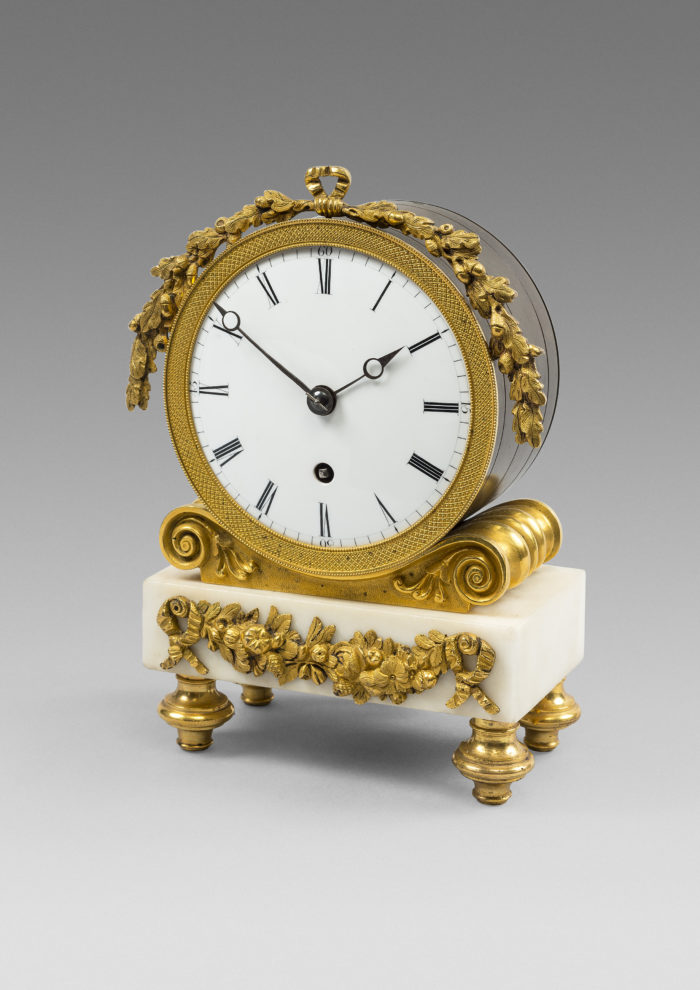
Small Gilt and Ormolu Timepiece by Baetens & Co, Soho. Raffety Ltd.
The high quality single fusee movement runs for a week and it has a white enamel dial with original moon-shaped hands. “BAETENS 23 Gerrard St, Soho London” is inscribed on a plate attached to the backplate of the clock.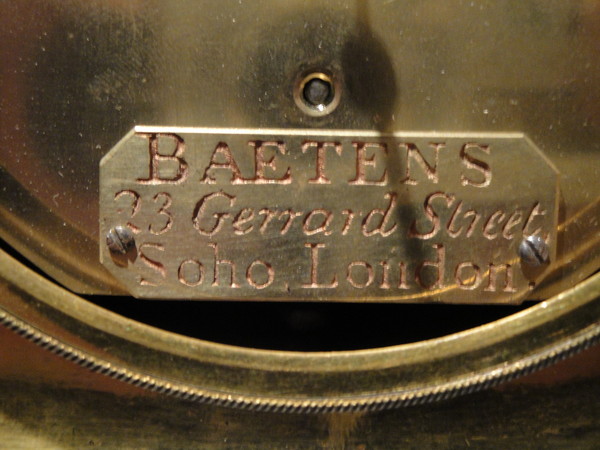
Detail of clock backplate with Baetens signature. Raffety Ltd.
The second example is a larger, grander clock, again in overtly neo-classical style with the drum clock dial placed between two columns, on a rectangular base. The base is decorated with berried foliage, masks and a central bronze recumbent lion.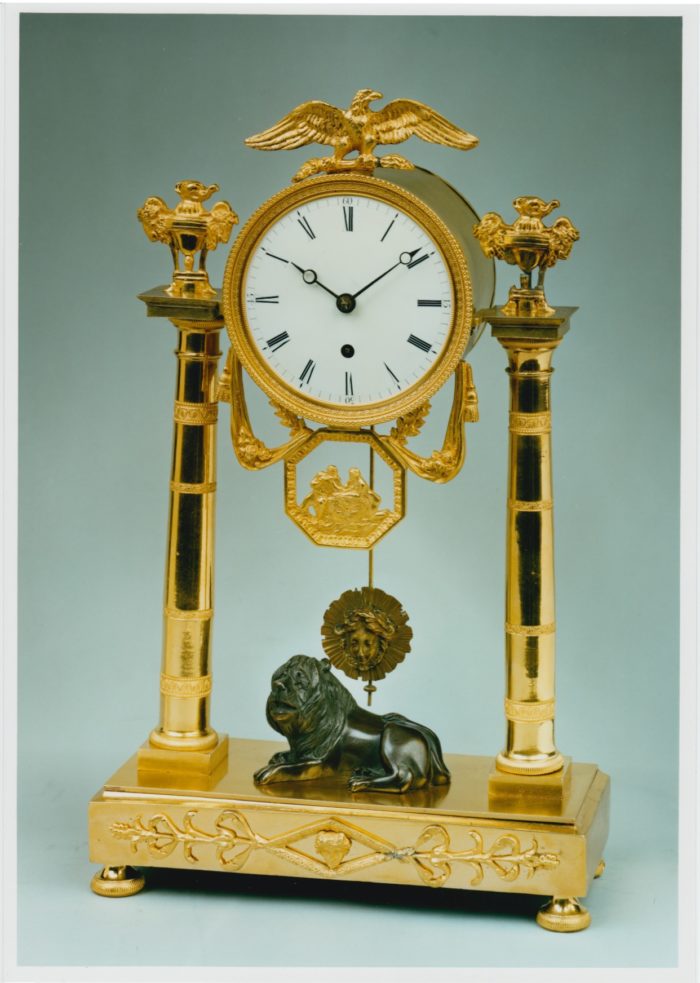
Mantel clock with bronze lion by Baetens, London. Raffety Ltd.
The fusee movement with enamel dial is fully signed on the backplate on a silvered cartouche, and the clock is surmounted by a gilded sculpture of an eagle with outstretched wings. This clock probably dates to around 1820.
Detail of the bronze lion on Baetens clock. Raffety Ltd.
Although neither movement on these two clocks is signed separately, there is at least one example of a Baetens clock that has a movement signed by clockmaker James Tupman, who was based at 44 Great Russell Street. Certainly the fusee movements they purchased for their designs were of a high standard, in keeping with the quality of their case designs.
Baetens & Co were not averse to copying parts of their designs from pattern books – they are known to have copied figures of “philosophy” and “study” designed by Louis-Simon Boizot for the Sevres Factory in 1780 into a clock which was in the collection of the 2nd Marquess of Bath at Longleat House (sold Christie’s, 13 June 2002) – it also employed a similar drum clock with ormolu swag mounts as its centrepiece.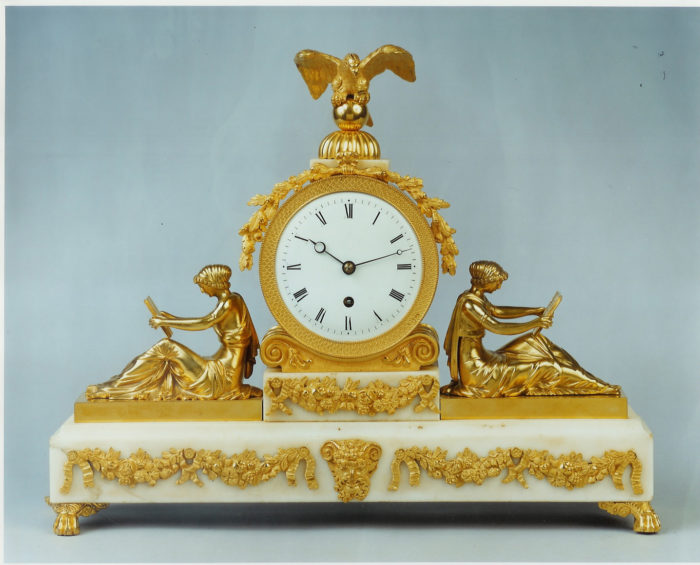
An example of the Philosophy & Study Clock by Baetens, Soho. Circa 1820. Baetens found this design was popular with clients and made a number of examples, varying the colour of the marble and using bronze mounts instead of ormolu. Former collection of Raffety Ltd.
Clocks with similar figures and crowned with an eagle had made by Dominque Daguerre for Lousi XVI and George IV is known to have bought copies of the design by other French clockmakers, so Baetens were merely following current trends and providing their clients with the styles they wanted.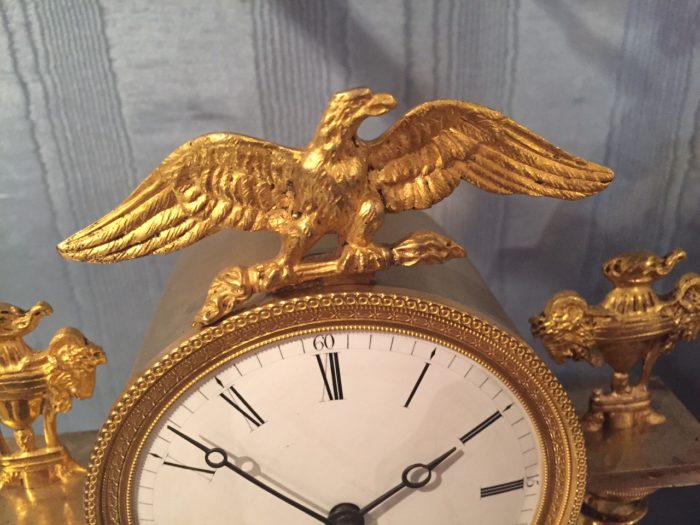 Detail of the ormolu eagle on the large classical clock with lion by Baetens, Soho. Raffety Ltd.
Detail of the ormolu eagle on the large classical clock with lion by Baetens, Soho. Raffety Ltd.
As well as the 2nd Marquess of Bath, Baetens also sold a clock to the British royal family, although it is not clear if the buyer was George IV. Described as “an upright rectangular marble mantel clock, crowned by a horse leaping over rocks” and signed by F. Baetens, it dates to about 1820 and is still in the Royal Collection today.
The firm continued into the reign of Queen Victoria, by which time Joseph Baetens had diversified the business to keep up with a changing economy and changing fashions. In 1840 he advertised in the Catholic Directory and Annual Register as a “Bronze and Ormolu Manufacturer” who could produce “all kinds of Church ornaments. He has lately executed Crucifixes, Candlesticks, &c. for the new Chapel at Everingham.” The business had by this time moved to premises at 18 Oxenden Street in Haymarket.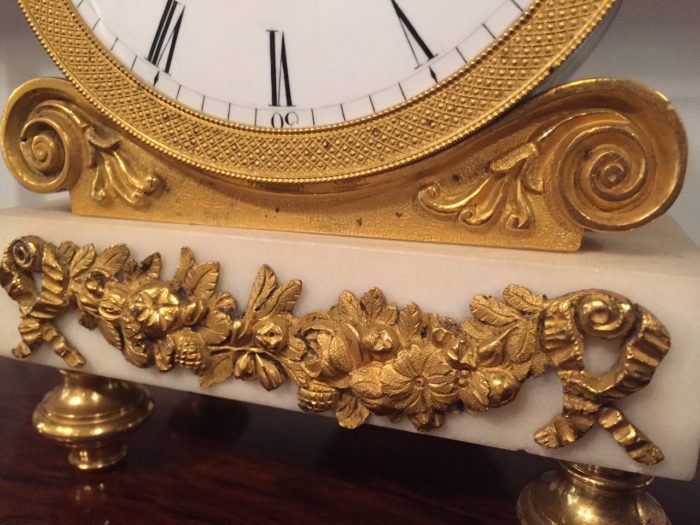 Detail of the exquisite ormolu decoration and details on the small library clock by Baetens, London. Raffety Ltd.
Detail of the exquisite ormolu decoration and details on the small library clock by Baetens, London. Raffety Ltd.
Without exception all the ormolu cases produced by Baetens & Co are of the highest quality, and incorporate English fusee movements of a consistently high standard. Their elegant, neoclassical designs were the height of fashion in the first half of the 19th century. Today they continue to be incredibly popular, and their narrower depth and smaller size makes them a perfect centrepiece for any modern fireplace.
by Tara Draper-Stumm with contributions by Nigel Raffety
Further Reading:
Cedric Jagger, Royal Clocks (London, 1983).
Brian Loomes, Watchmakers and Clockmakers of the World (21st Century Edition, London, 2006).
Listings for Baetens & Co can be found in the Post Office Directory (1814),
Kent’s London Directory (1820) and The Catholic Directory & Annual Register (1840).
One of the companies to take advantage of this burgeoning business was Baetens & Co. It was based from at least 1814 at 23 Gerrard Street in Soho, and was run by F. Baetens, who appears to have later gone into business with his son or relative Joseph Baetens.
Baetens & Co were not traditional clockmakers as you would have found in the first half of the 18th century – they seem not to have been “clockmakers” in the traditional sense at all, but rather specialist craftsmen in ormolu and bronze. Where in the early 18th century clockmakers had made the various parts of the clock movement and put these together, they generally had not make the cases, working instead with cabinet makers who produced cases in fine woods for them.
Baetens & Co are an example of the expansion and development of the clockmaking business in London – they made exquisite ormolu mounts and ormolu and bronze clock cases and then bought in ready-made clock movements to fit into their designs, signing and marketing the finished product.
Raffety currently has two fine examples of Baetens & Co clocks on view in the gallery.
The first is a small and unusual library timepiece in neo-classical style, consisting of a white enamelled clock set into an ormolu and gilded mount, on a white marble base. The original ormolu mounts include swag decoration to the marble base and elegant, turned feet. The top of the clock is crowned with gilded ormolu ribbons. It probably dates to about 1830.

Small Gilt and Ormolu Timepiece by Baetens & Co, Soho. Raffety Ltd.
The high quality single fusee movement runs for a week and it has a white enamel dial with original moon-shaped hands. “BAETENS 23 Gerrard St, Soho London” is inscribed on a plate attached to the backplate of the clock.

Detail of clock backplate with Baetens signature. Raffety Ltd.
The second example is a larger, grander clock, again in overtly neo-classical style with the drum clock dial placed between two columns, on a rectangular base. The base is decorated with berried foliage, masks and a central bronze recumbent lion.

Mantel clock with bronze lion by Baetens, London. Raffety Ltd.
The fusee movement with enamel dial is fully signed on the backplate on a silvered cartouche, and the clock is surmounted by a gilded sculpture of an eagle with outstretched wings. This clock probably dates to around 1820.

Detail of the bronze lion on Baetens clock. Raffety Ltd.
Although neither movement on these two clocks is signed separately, there is at least one example of a Baetens clock that has a movement signed by clockmaker James Tupman, who was based at 44 Great Russell Street. Certainly the fusee movements they purchased for their designs were of a high standard, in keeping with the quality of their case designs.
Baetens & Co were not averse to copying parts of their designs from pattern books – they are known to have copied figures of “philosophy” and “study” designed by Louis-Simon Boizot for the Sevres Factory in 1780 into a clock which was in the collection of the 2nd Marquess of Bath at Longleat House (sold Christie’s, 13 June 2002) – it also employed a similar drum clock with ormolu swag mounts as its centrepiece.

An example of the Philosophy & Study Clock by Baetens, Soho. Circa 1820. Baetens found this design was popular with clients and made a number of examples, varying the colour of the marble and using bronze mounts instead of ormolu. Former collection of Raffety Ltd.
Clocks with similar figures and crowned with an eagle had made by Dominque Daguerre for Lousi XVI and George IV is known to have bought copies of the design by other French clockmakers, so Baetens were merely following current trends and providing their clients with the styles they wanted.
 Detail of the ormolu eagle on the large classical clock with lion by Baetens, Soho. Raffety Ltd.
Detail of the ormolu eagle on the large classical clock with lion by Baetens, Soho. Raffety Ltd.As well as the 2nd Marquess of Bath, Baetens also sold a clock to the British royal family, although it is not clear if the buyer was George IV. Described as “an upright rectangular marble mantel clock, crowned by a horse leaping over rocks” and signed by F. Baetens, it dates to about 1820 and is still in the Royal Collection today.
The firm continued into the reign of Queen Victoria, by which time Joseph Baetens had diversified the business to keep up with a changing economy and changing fashions. In 1840 he advertised in the Catholic Directory and Annual Register as a “Bronze and Ormolu Manufacturer” who could produce “all kinds of Church ornaments. He has lately executed Crucifixes, Candlesticks, &c. for the new Chapel at Everingham.” The business had by this time moved to premises at 18 Oxenden Street in Haymarket.
 Detail of the exquisite ormolu decoration and details on the small library clock by Baetens, London. Raffety Ltd.
Detail of the exquisite ormolu decoration and details on the small library clock by Baetens, London. Raffety Ltd.Without exception all the ormolu cases produced by Baetens & Co are of the highest quality, and incorporate English fusee movements of a consistently high standard. Their elegant, neoclassical designs were the height of fashion in the first half of the 19th century. Today they continue to be incredibly popular, and their narrower depth and smaller size makes them a perfect centrepiece for any modern fireplace.
by Tara Draper-Stumm with contributions by Nigel Raffety
Further Reading:
Cedric Jagger, Royal Clocks (London, 1983).
Brian Loomes, Watchmakers and Clockmakers of the World (21st Century Edition, London, 2006).
Listings for Baetens & Co can be found in the Post Office Directory (1814),
Kent’s London Directory (1820) and The Catholic Directory & Annual Register (1840).

